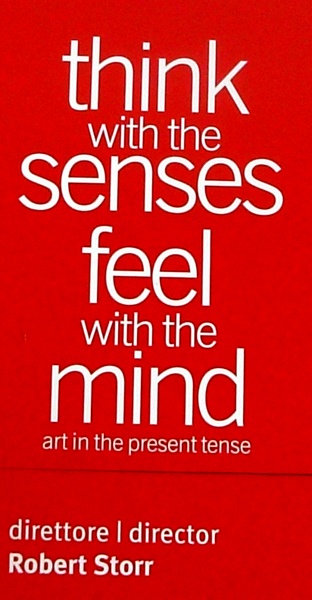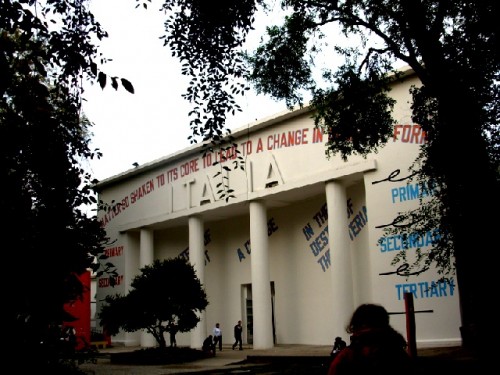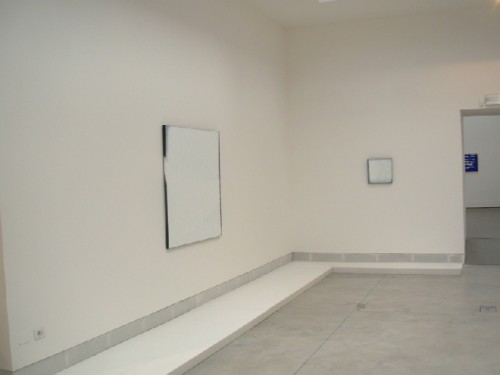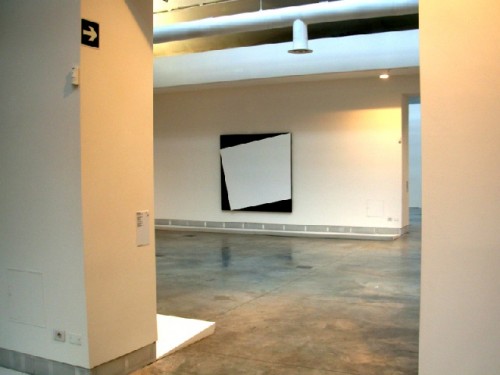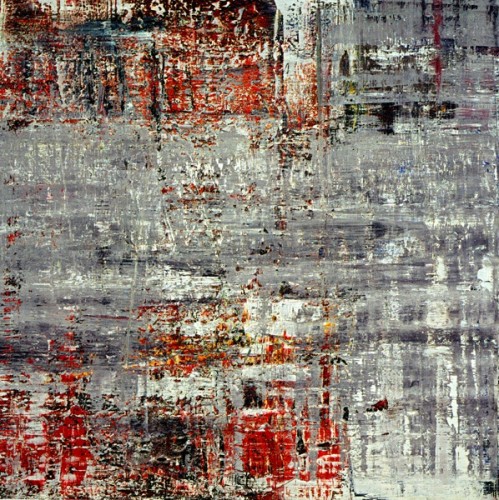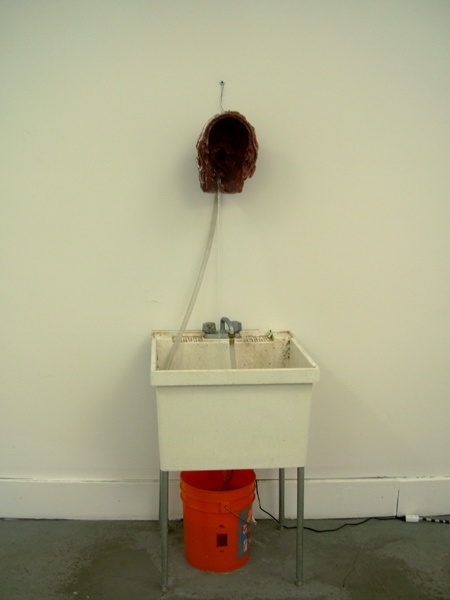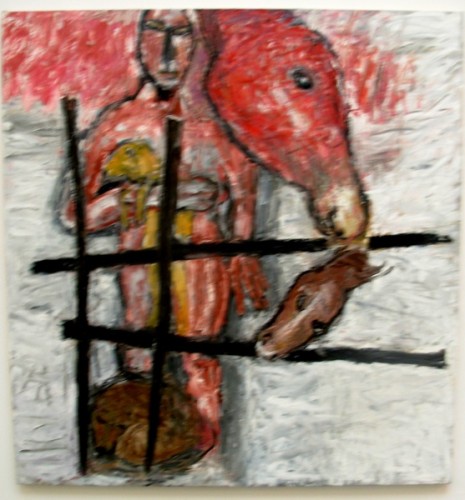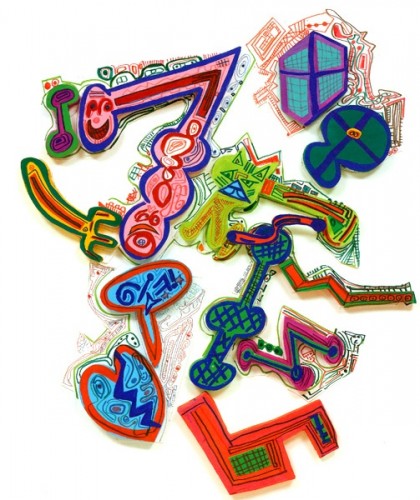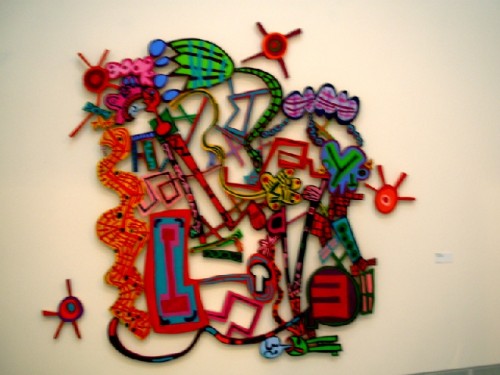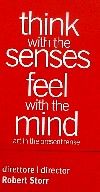The Robert Storr Venice Biennale 2007
Think With the Senses, Feel With the Mind
By: Charles Giuliano - Nov 26, 2007
Think With the Senses, Feel With the Mind: Art in the Present Tense
La Biennale di Venezia, 52. Esposizione Internationale d'Arte
Curated and edited by Robert Storr with short texts by Lindsay Harris, Joe Hill, Sarah Lewis, Ann Mecugni, Francesca Pietropaolo, and Robert Storr. Editor of texts of volume one, Harriet Bee. Catalogue Graphic Design, Dario e Fabio Zannier. Editorial coordination, Francesca Del Puglia, Chiara Calciolari, Velentina Vecchio, Lucia Veronesi. Three volumes: Volume One, Art in the Present Tense, 392 pages. Volume Two, Participating Countries, Collateral Events, 338 pages. Volume Three: Pages in the Wind: A Reader, Texts Chosen by the Artists of the 52nd International Art Exhibition, 94 pages. Published by Marsilio Editions, Printed by Offset Print Veneta, Verona.
ISBN 978-88-317-9256. Distributed by Windsor Books, 2007.
http://www.labiennale.org/en
The 52nd Bienalle di Venezia ended on November 21 but having visited rather late in its run we are still sorting through an onslaught of visual information, issues and ideas. Having returned from a three week visit including a week in Venice divided between visiting the Bienalle, for two full days at the Giardino and Arsenale, as well as, some of the numerous pavilions and special exhibitions scattered around a difficult to navigate and complex topography there is much to put in order. We also spent time in several churches to view works by Titian, Canova, and Tintoretto, an afternoon each in the Academia and the Peggy Guggenheim Museum, as well as exploring San Marco and the Doge's Palace and the fascinating Museo Fortuny.
So what follows are comments on Our Venice and the Biennale and is a far from complete or definitive report. Having read other reviews we realize that there is so much that we missed although we pushed our eyes, bodies, and minds to the very brink of human endurance. And I have spent many hours over a couple of weeks just downloading some 2,000 images taken while visiting seven cities.
Particularly in Venice taking pictures seems oddly redundant. It has to be the most painted, drawn and photographed city in the world. The notion of originality is not a part of the equation. There are cameras constantly clicking all around you. So there is virtually no possibility of recording anything unique. This prompts a different approach to using images as a form of note taking. To remind me, in the process of preparing these reports, of just what we saw and how to organize that information. The actual memory fades quickly with more lost each passing day. But an image is a means of fixing on and recovering an experience. Often we remember not actual people and places but our fixed images of them.
I put a bunch of reporter's notebooks and a stock of pens in my back pack but ended the journey having written not a single word. That surprised me as I had planned to fill several notebooks with an ongoing journal. It is also why I never took notes during lectures in graduate school. That would have distracted from concentrating on the presentations.
The massive, three volume catalogue for the Biennale, including the essay by its director, the American artist and curator, Robert Storr, has been of limited value. Had I not visited Venice and seen the Biennale with my own eyes I would be utterly lost to make any sense of it based on this extensive suite of three volumes. Because of deadlines, the norm for such publications is that what is reproduced in the catalogue is not the work as it was actually installed. Sometimes museums hold off on the publication waiting for installation shots and the text may come during the run of the show or even after it is dismantled. But for projects like a Biennale there is a mandate that the catalogue be ready for the vernissage. So the essayists, as well as readers, have to speculate on the impact of a project as it was actually installed. Which in a sprawling project, such as this, is all the more significant. A list of artists scribbled on the back of a napkin during a meeting may be rather different in theory than in practice.
With hindsight it is entirely possible, particularly in light of often scathing reviews, that Storr might want to buy a vowel or take back some of his cronyism and elitist decisions to go with an enervating group of mostly A List international artists. File them under the category of Usual Suspects (Sigmar Polke, Gerhard Richter, Franz West, Martin Kippenberger, Chen Zehn) as well as outtakes from MoMA retrospectives where he was formerly (13 years) ensconced: Elizabeth Murray, yawn, Robert Ryman, oh well, Ellsworth Kelly, samosamo, Bruce Nauman, yaddayaddayadda, and his significant other the enervating Susan Rothenberg, the predictable Jenny Holzer who reprsented the U.S.A in its pavilion in 1990, here we go again, Sol Lewitt, give me a break, Louise Bourgeois, the obligatory, Kara Walker, a text message by Lawrence Weiner, and, thanks for the sparing memories, Fred Sandback. The only puzzle here is why, if he selected Polke and Richter, he left out the other of the Big Three of contemporary German art, Anselm Kiefer? What a slight.
While in a different country and city the Storr installation in the Italia Pavilion in the Giardino felt much like yet another MoMA or even Whitney show. Sure, many of these artists are ensconced in the canon of contemporary art, and rightly so, but do I have to travel to the Venice Biennale to contemplate them yet again? The idea of a Biennale is to experience something fresh and challenging while at least half of the Storr project, the Italia Pavilion, was a no brainer. The more risky part of his stewardship we viewed on our second day at the Arsenale which proved to be far more absorbing with a greater degree of difficulty and risk taking.
Part of the critical response to this 52nd Biennale entails the overview that Storr was given longer lead time than other directors, three years, with a mandate to bring order to what has often been viewed as chaotic; particularly the clutter of the Arsenale which used to house the Aperto or survey of Emerging Artists. The thinking was that appointing a major American curator with substantial mainstream credentials (MoMA) would provide clarity and discipline. Nobody quite factored in that the result would be a bore. The selection of work felt like it had been drawn up during a New York dinner party. It had that Judy Garland/ Mickey Rooney aura of "Hey kids lets all go to Venice."
Then there is the matter of installation. In general, Europeans appear to favor natural light of medium to low intensity. So the illumination in the exhibition proved to be of such cool and low intensity, particularly during the overcast fall week when we visited, that subtle works like the white on white paintings of Ryman, or the monochromatic geometric shapes of Kelly, the dark on dark paintings of Polke, and the chicken scratches on canvas by Richter proved to be all but invisible. Even if one took the trouble to adjust to the crappy lighting. For myself, I prefer to view paintings when they are blasted with tungsten which is the norm when visiting galleries intent on selling the work. Once a work is sold curators want to conserve it for the next millennia which means that they don't let you actually see it.
Walking around the Italia Pavilion I found myself getting more and more annoyed hoping against hope to find something new and interesting. Faggedahboutit. Instead, there, once again were those odd little "shaped" cartoony, brightly colored, last works by the late and overrated Elizabeth Murray. Her MoMA retrospective bored me to tears and it wasn't any better to experience a few of those paintings yet again. Ditto Susan Rothenberg and those Fences and Horses. Why? She lives out West with Bruce Nauman and his take on it is a lot more interesting. Her presence here is described as a coup as she rarely consents to be including in such exhibitions because she resents being one of the token women. But Storr really didn't do me a favor as I have never been terribly interested in that work.
Which was not the case with another "token" woman, Jenny Holzer. She really reinvented herself with the "Redaction" paintings which were introduced at Cheim & read in 2006. A selection of her large, silk screen "paintings" of appropriated texts obtained through the Freedom of Information Act, shedding light on the mishandling of the wars in Iraq and Afghanistan, proved to be the most relevant and provocative work installed in the Italia Pavilion. It was the exception to disappointment that this project is taking place during a time of Global conflict and political turmoil. We were relieved to encounter an array of work engaged with these issues during the visit to the Arsenale which is the subject of our next report.
Given the predictable and safe nature of most of the selection we would score the Storr installation as, at best, a five on a scale of ten. Or put another way "Think With the Senses, Feel With the Mind," how vague is that, could have been more accurately titled "New York New York." Or "Me and Me Mates." Good grief.

